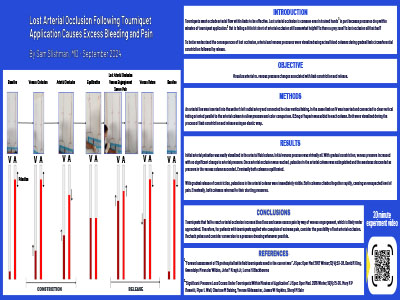ABSTRACTS
Lost Arterial Occlusion Following Tourniquet Application Causes Excess Bleeding and PainAuthor: Sam Slishman | | Associate Authors:
Introduction: Tourniquets must occlude arterial flow within limbs to be effective. But is falling a little bit short still somewhat helpful. Objective: To visualize arterial versus venous pressure changes associated with limb constriction and release. Methods: Arterial and venous pressures were directly assessed during gradual limb constriction followed by release. An arterial line was inserted into the author's left radial artery and connected to clear vertical tubing. In the same limb, an IV was inserted and connected to clear vertical tubing oriented parallel to the arterial fluid column to allow pressure and color comparison. Then, 0.5 mg of heparin was added to each column. Both fluid columns were visualized during the process of limb constriction and release using an elastic wrap. Results: Initial arterial pulsation was easily visualized in the arterial fluid column. Initial venous pressure was essentially nil. Once arterial occlusion was reached following constriction, pulsation in the arterial column was extinguished and the meniscus descended, while pressure in the venous column ascended. Both columns equilibrated. With gradual release of constriction, pulsations in the arterial column were immediately visible. Both columns climbed together rapidly, causing an unexpected level of pain. Eventually, both columns returned to their initial pressures. Conclusion: Tourniquets that fail to reach arterial occlusion increase blood loss and cause excess pain by way of venous engorgement. For patients with tourniquets applied who complain of extreme pain, consider the possibility of lost arterial occlusion. Recheck pulses and consider conversion to a pressure dressing whenever possible.
|

